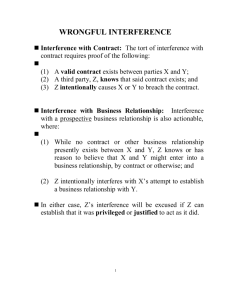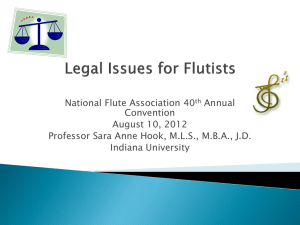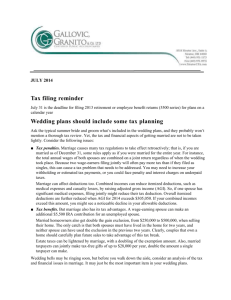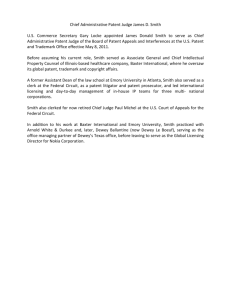Patents, Trademarks, and Copyrights
advertisement
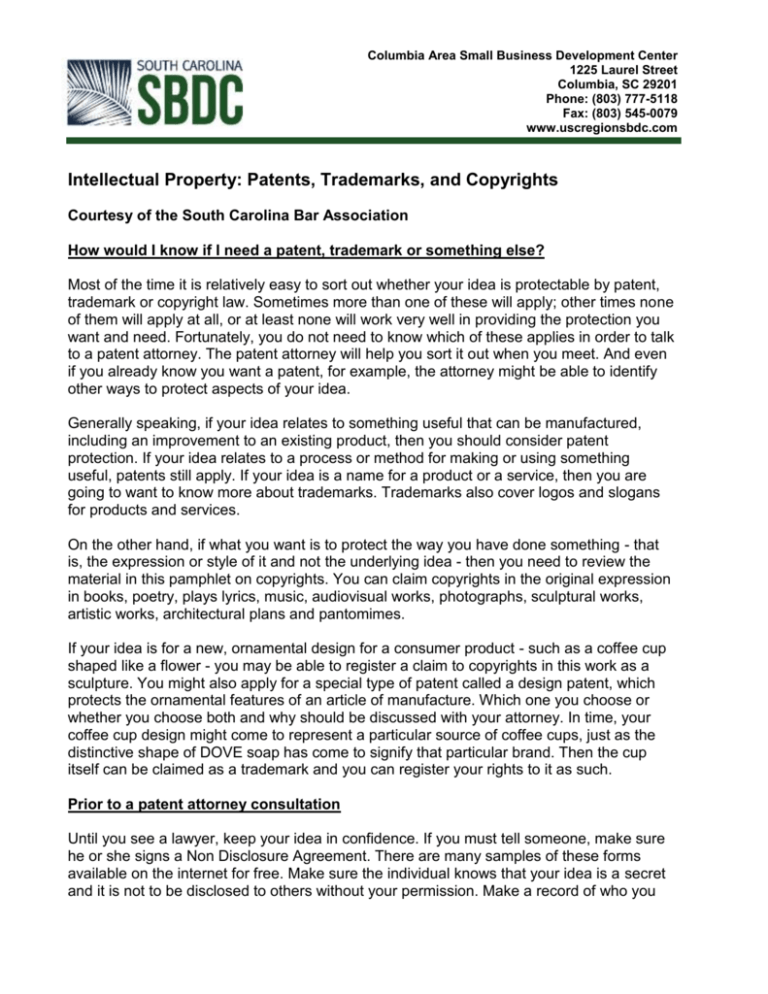
Columbia Area Small Business Development Center 1225 Laurel Street Columbia, SC 29201 Phone: (803) 777-5118 Fax: (803) 545-0079 www.uscregionsbdc.com Intellectual Property: Patents, Trademarks, and Copyrights Courtesy of the South Carolina Bar Association How would I know if I need a patent, trademark or something else? Most of the time it is relatively easy to sort out whether your idea is protectable by patent, trademark or copyright law. Sometimes more than one of these will apply; other times none of them will apply at all, or at least none will work very well in providing the protection you want and need. Fortunately, you do not need to know which of these applies in order to talk to a patent attorney. The patent attorney will help you sort it out when you meet. And even if you already know you want a patent, for example, the attorney might be able to identify other ways to protect aspects of your idea. Generally speaking, if your idea relates to something useful that can be manufactured, including an improvement to an existing product, then you should consider patent protection. If your idea relates to a process or method for making or using something useful, patents still apply. If your idea is a name for a product or a service, then you are going to want to know more about trademarks. Trademarks also cover logos and slogans for products and services. On the other hand, if what you want is to protect the way you have done something - that is, the expression or style of it and not the underlying idea - then you need to review the material in this pamphlet on copyrights. You can claim copyrights in the original expression in books, poetry, plays lyrics, music, audiovisual works, photographs, sculptural works, artistic works, architectural plans and pantomimes. If your idea is for a new, ornamental design for a consumer product - such as a coffee cup shaped like a flower - you may be able to register a claim to copyrights in this work as a sculpture. You might also apply for a special type of patent called a design patent, which protects the ornamental features of an article of manufacture. Which one you choose or whether you choose both and why should be discussed with your attorney. In time, your coffee cup design might come to represent a particular source of coffee cups, just as the distinctive shape of DOVE soap has come to signify that particular brand. Then the cup itself can be claimed as a trademark and you can register your rights to it as such. Prior to a patent attorney consultation Until you see a lawyer, keep your idea in confidence. If you must tell someone, make sure he or she signs a Non Disclosure Agreement. There are many samples of these forms available on the internet for free. Make sure the individual knows that your idea is a secret and it is not to be disclosed to others without your permission. Make a record of who you tell your idea to and when. If possible, have those you discuss your idea with acknowledge in writing that, on that day, you disclosed the idea to them and that they understood that it was disclosed in confidence. Another thing that is important to do before seeing a lawyer is to think about all applications of the idea. If your idea is for an invention, think about its specifications (documented in a diagram), how it will be made, what materials will be used, what optional features will be included, as many applications for the use of the product as you know, and how you will market it. The more complete your idea is, the easier it will be for your patent attorney to advise you and the stronger your claim to rights in that idea will be. There are organizations that claim to help inventors. Some may be helpful while others are not. Before you disclose your idea to one of them or pay them any money, find out as much as you can about the organization through the Better Business Bureau, the state and federal consumer advocate's office, the Federal Trade Commission and other sources. Ask for references and inquire as to how long they have been in business under the same name. Ask for information about their success rate. Be skeptical. What are Patents? Patents are documents issued by the federal government. These documents grant the owner the right to exclude others from making, selling and using the invention as it has been described and claimed in the specification attached to the patent. You do not need a patent to make, use or sell something, only to stop others from doing so. What do Patents protect? Patent rights are granted for new, useful and non-obvious machines, articles of manufacture, compositions of matter and processes for making and using any of these. You can obtain patents on improvements to existing devices as well. Sometimes combinations of well-known things can be patented, as long as the combination is new, useful and non-obvious. Patents cannot be granted for certain types of ideas. Two examples are business plans and printed matter. However, if you believe that your idea is commercially valuable, please have an attorney knowledgeable in intellectual property law review it with you. How do I get a Patent? To be awarded a patent, you need to file an application with the U.S. Patent and Trademark Office. The application must include a description of the invention, including the best mode for practicing the invention and at least one claim. It must contain a drawing of the invention if a drawing would help in the understanding of the invention. The application must also contain an oath or declaration that the applicant believes himself to be the original inventor of the subject matter claimed. Finally there is also a fee for filing the application. Although it is possible for an inventor to prepare and file his or her own application, it is not a good idea. Patent law is a legal specialty, and lawyers themselves must pass a special bar examination to practice patent law. However, an inventor can and should work closely with a patent attorney to make sure that the patent application is a full and accurate statement of the invention and by doing so, he or she will not only ensure that the resulting patent meets their needs but that the cost of obtaining it will be reasonable. After that patent application is filed, a patent examiner at the Patent and Trademark Office examines it. The examiner may have questions about the application and may reject it. The applicant acting through his attorney has the right to amend the application and request reconsideration of it. There are other procedures in the practice of patent law that can be used to obtain the allowance of the patent. Much of the examination centers on the claims. The claims are numbered paragraphs at the end of the specification. Each is a single sentence describing the invention that is claimed. The invention may be claimed in a number of ways, and it is best to claim it several ways. The focus of the examiner is to make certain the claims describe the inventor's invention and no one else's and to do so in clear and concise language. The patent applicant and the attorney share these same goals; however, they also want the claims to be a broad statement of the invention. The examination of the patent can take longer if the applicant and the examiner are unable to agree on language that will satisfy all of their goals. However, the scope of the claims has a great bearing on the value of the patent, and the time spent on their precise wording is often well worth the cost. What are Trademarks? The word "trademark' is usually associated with well-known product names, such as BETTY CROCKER, Kitchen AID, or FORD. Many people are surprised to learn, however, that things other than product names or company logs can also serve as trademarks. In fact, a trademark can be virtually any work, name, symbol or device used to distinguish the goods or services of one individual or company from the goods or services of another. For example, while the name COCA-COLA is a trademark, the shape of a Coke bottle can be too. A color, like the pink color of OWENS-CORNING fiberglass, can also serve as a trademark, as well as the particular dial tone used by a long-distance caller. When the word, name, symbol or device is used to identify a service, it is usually referred to as a "service mark." For example, MCDONALD'S is a well-known service mark for restaurant services. Other types of trademarks include "certification marks," such as the UL symbol and "collective marks," such as the emblem of a union or a fraternal organization. What do Trademarks protect? The owner of a trademark has the right to prevent others from using the same or a similar trademark in a manner that is likely to confuse the consuming public. If it becomes necessary to enforce a trademark in court, a common remedy is an injunction. In other words, the court will order the trademark infringer to stop using the mark. In many cases, the court will also award profits that the trademark owner lost due to the infringement. The attorney's fees paid by the trademark owner in bringing the lawsuit can also be awarded in exceptional cases. If the trademark is "famous," it is entitled to even greater protection. The owner of a famous mark can prevent others from using that mark in a commercial manner that causes "dilution." Dilution means that the capacity of the mark to identify and distinguish the goods or services of its owner has been lessened. Unlike trademark infringement in the ordinary sense, there is no need to demonstrate likelihood of confusion in order to show dilution of a famous mark. The law also provides special remedies when an infringer counterfeits a federally registered trademark. In this case, the trademark owner is normally entitled to receive attorney's fees plus a monetary award in the amount of three times the actual damages caused by the infringement. In the alternative, the trademark owner can elect to receive statutory damages in an amount fixed by the court. This allows the trademark owner to receive an effective remedy when actual damages would be difficult to prove. How do I get rights to a Trademark? In many cases, rights in a trademark can be established by simply using the trademark in the ordinary course of business. To acquire trademark rights, however, the trademark must have been chosen and adopted in good faith. In other words, the trademark user must believe that the mark does not pose a conflict with other marks currently used in the market place. In addition, the rights acquired by a trademark user are subject to any superior rights held by another party. For example, another party may have previously registered the mark or used the mark in the same geographic area. In this case, the trademark may not be free for use, even if the later party had no knowledge of the superior rights. To provide greater assurance that a mark is free for use, many companies will obtain a trademark search from an attorney who works in this field. Trademarks can be registered at the U.S. Patent and Trademark Office or any of the designated state agencies within each state. While trademark registration is not mandatory, it often gives the trademark owner significant advantages. This is particularly true in the case of federal registration, which can give priority rights that are nationwide scope. Traditionally, a trademark owner had to begin actual use of the mark before an application for registration could be filed. However, application for federal registration can also be filed based on a bona fide intent to use the mark in commerce. This procedure allows a mark to be approved by the government before major expenses have been incurred in promoting it. Actual use of the mark must begin, however, before the trademark registration can be granted. What can you Copyright? Under the Copyright Act, copyright protection is available for original work of Authorship fixed in a tangible medium of expression." To better understand what "works" are protected by copyrights this statement should be examined step-by-step. First, the work must be "original." This means' that the person claiming copyright protection must have created the work through the application of some independent intellectual or artistic effort. In other words, they cannot be copied from an existing source or merely exist of an arrangement of information that is in the public domain, e.g., a calendar or height and weight charts. Second, the work must be "fixed in a tangible medium." This means that the work must be embodied in a form that is sufficiently permanent or stable to permit it to be perceived, reproduced or otherwise communicated for a period of time. For instance, a live piano performance is fixed when it is recorded on a tape cassette; a play is fixed when it is taped by a video camera; a story is fixed when it is written on paper; a painting is fixed when the paint is applied to canvas; and a musical composition is fixed when the musical notes and instrumentation are written on paper. To better understand what works are the subject matter of copyrights, the Copyright Act specifically lists eight types of works that are considered to automatically be "original works of authorship fixed in a tangible medium of expression." There are eight types of these works: • • • • • • • • Literary works Musical works Dramatic works Pantomimes and choreographic works Pictorial, graphic and sculptural works Motion pictures and other audiovisual works Sound recordings Architectural works What do Copyrights protect? The owner of a copyright has certain rights that are provided by the Copyright Act. These rights are: • • • • • Reproduction- The copyright owner, or one acting with his or her permission, may exclude others from making copies of the copyrighted work. Adaption- The owner of the copyright in a work has the sole right to prevent others from transforming the original work into another form, such as a dramatization, translation, condensed version or musical arrangement. Distribution- The owner of a copyright has the exclusive right to distribute the work to the public, whether by sale, rental or loan. However, once a copy of the work has been transferred to another party, the copyright owner loses control over that particular copy. Thus, the buyer may resell the copy without infringing the copyright owner's right to distribute Performance- Only the copyright owner has the exclusive right to "perform" the copyrighted work publicly. It is important to note that a performance is .considered to be public if it happens at a place open to the public or to a gathering outside your normal circle of family and friends. Furthermore, to perform a work means to recite, render, play, dance or act it, either directly or by means of any device. Thus, the showing of a videotape on a television monitor or the playing of a compact disc on a CD player constitutes a performance. Display- Only the copyright owner has the exclusive right to "display" the work. To display means the showing of a copy, either directly or by projection or by electronic transmission. However, the rightful owner of a copy may display that copy to viewers present at the place where the copy is located. How do I get Copyrights? A common misconception about copyrights is that you must register with the federal government to own copyrights in a work that you have created. This is not correct. Copyright protection is afforded to an author of an original work the moment that it is fixed in a tangible form. Although copyright registration is not required to receive copyright protection, registration does afford the copyright owner the following advantages: • • Registration establishes a public record of the copyright claim. Before an infringement suit may be filed in court, registration is necessary for works created in the United States and for foreign works not originating in a Berne Union Country. • If registration is made before or within five years of publication, registration will presumptively establish in court the validity of the copyright and the facts stated in the certificate, such as author, date of creation and title. • If registration is made within three months after publication of the work or prior to an infringement of an unpublished work, statutory damages and attorney's fees will be available to the copyright owner in a copyright infringement lawsuit. Otherwise, only an award of actual damages and profits is available to the prevailing copyright owner. Copyright registration provides a mechanism that permits the copyright owner to record the registration with U.S. Customs Service for protection against infringing imports.



